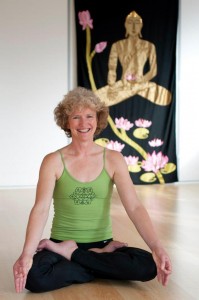Cathy Haworth runs BAYoga Studio in Berkhamsted, Herts. She teaches Ashtanga vinyasa yoga and particularly enjoys teaching ‘Mysore’ style classes. I’m one of her Mysore students and I asked her a few questions about this style.

CW: Where does the Mysore style of ashtanga yoga come from?
CH: Mysore is a town in Southern India where the founder of Ashtanga vinyasa yoga, Shri K Pattabhi Jois lived. Since his death in 2009 his grandson Sharath continues running the shala and each year thousands of ashtangis go to Mysore to practice with him. I’m planning on visiting for the first time this summer and I can’t wait.
CW: How would you describe Mysore style?
CH: Ashtanga yoga is a dynamic style of yoga where movement is synchronised with the breath. There’s a set sequence of poses which are held for five breaths and you then move onto the next posture.
To practice ashtanga yoga ʻMysore styleʼ is to practice the ashtanga sequence in a class situation but at your own pace. You follow your own individual length of breath, receiving guidance and adjustments from your teacher on a one to one basis. I, or whoever is teaching, don’t lead the class as such.
Learning the ashtanga sequence may at first appear a little daunting, but myself or your teacher is there to assist and we take it slowly.
As you learn and grow confident in each pose, you’re given new poses by your teacher, making this a very personal journey. Once learnt you have a practice for life.
CW: What’s so special about a Mysore practice?
CH: Moving with your own breath at your own pace enables you to work at your own level, extending the breath as it suits you. We all have different lengths of breath and this way of practicing enables you to be in charge of your own destiny.

It is a disciplined approach to yoga that allows for no opt out of poses because you find them challenging. You have to face up to every eventuality that the pose may bring.
Thereʼs no hiding, and by working with your own breath you can really connect to what may be happening both in the pose internally and externally. By bringing this discipline into your life enables you to be more focused and present not just on your yoga mat but in all aspects of your life.
It gives you the space to be you.
Whilst on your mat, working and moving with your breath, you are able to let go of the outside world and be in the present moment, allowing the real you to shine through.
Once off the mat we take on board the many outside influences that we have accumulated over the years and often act in a very different way to who we really are.
Being on the mat allows us to be true to ourselves and the more you practice, the more you are able to let go of this external ʻbaggageʻ and allow yourself the space and freedom of just being who you really are.
CW: You’ve mentioned before to me about the versatility that these classes offer. How is that?
CH: You don’t have to be on your mat at the very start of a class. You come when it suits you. If you get stuck in traffic, if you have to drop the kids off at school… that’s fine, no rush. The latest start time is one hour before the end of the class.
Classes vary in length from 2-3 hours at BAYoga Studio and if you’re a beginner you’ll need to allow approximately an hour to do your practice. Eventually, as you progress you will build on this to 1.5-2 hours.
One of the many joys of a Mysore practice is that it is very portable. I know that wherever I may be in the world, I’ll have the opportunity of going to a class knowing exactly what to expect from an ashtanga Mysore style class. Get on your mat in Paris, Sydney, New York or India and you know that you will be just fine regardless!
CW: Thank you Cathy.
Cathy teaches Mysore style classes at various times throughout the week. Find out more by visiting bayogastudio.co.uk. On a Tuesday morning she teaches a Mysore style class from 9.15-11.15am and then I teach a yin yoga class from 11.30-1pm at BAYoga Studio. Come along to both classes for only £16. It’s a bargainous morning of yin and yang.
Cathy and I will be teaching an ashtanga/yin retreat together 3-5 October 2014. Visit the retreats page for more details.
Do you practice Mysore style Ashtanga? What do you enjoy about it? Feel free to comment below.
Read my previous teacher interviews with:
Norman Blair, my yin teacher
April Nunes Tucker, my local yogi partner in crime
Lila Conway, who taught me how to teach Sivananda yoga on my first teacher training.





